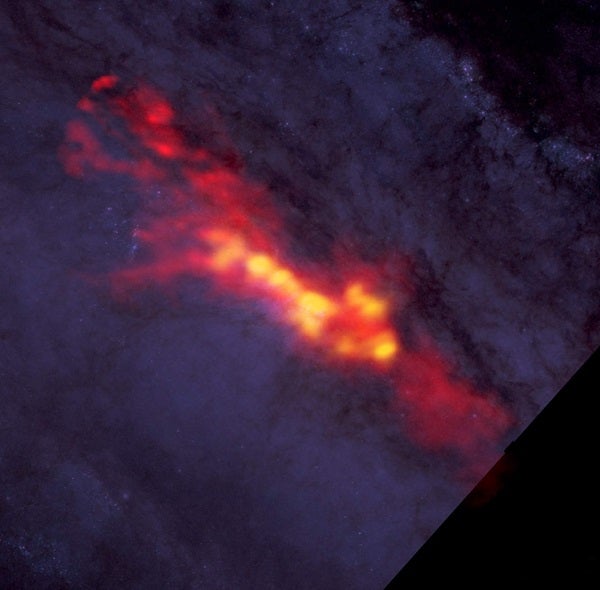Astronomers used the Very Large Telescope (VLT) to uncover a host of new young, massive, and dusty stellar nurseries in nearby galaxy NGC 253. The center of this galaxy appears to harbor a twin of our own Milky Way’s supermassive black hole.
Astronomers from the Instituto de Astrofísica de Canarias, Spain, used the Nasmyth Adaptive Optics System and Near-Infrared Imager and Spectrograph (NACO), a sharp-eyed adaptive optics instrument on European Southern Observatory’s (ESO) VLT, to study the fine detail in NGC 253, one of the brightest and dustiest spiral galaxies in the sky. Adaptive Optics (AO) corrects for the blurring effect introduced by Earth’s atmosphere. This turbulence causes the stars to twinkle in a way that delights poets, but frustrates astronomers, because it smears the images. With AO in action, the telescope can produce images that are as sharp as is theoretically possible, as if the telescope were in space.
NACO revealed features in the galaxy that were only 11 light-years across. “Our observations provide us with so much spatially resolved detail that we can, for the first time, compare them with the finest radio maps for this galaxy – maps that have existed for more than a decade,” said Juan Antonio Fernández-Ontiveros, the lead author of the paper reporting the results.
Astronomers identified 37 distinct bright regions, a threefold increase on previous results, packed into a tiny region at the core of the galaxy, comprising just one percent of the galaxy’s total size. The astronomers combined their NACO images with data from another VLT instrument, the Imager and Spectrometer for mid Infrared (VISIR,) as well as with images from the National Aeronautics and Space Administration (NASA)/European Space Agency (ESA) Hubble Space Telescope and radio observations made by the Very Large Array and the Very Large Baseline Interferometer. Combining these observations, taken in different wavelength regimes, provided a clue to the nature of these regions.
“We now think that these are probably very active nurseries that contain many stars bursting from their dusty cocoons,” said Jose Antonio Acosta-Pulido, a member of the team. NGC 253 is known as a starburst galaxy, after its very intense star formation activity. Each bright region could contain as many as 100,000 young, massive stars.
This comprehensive set of data also leads astronomers to conclude that the center of NGC 253 hosts a scaled-up version of Sagittarius A, the bright radio source that lies at the core of the Milky Way and harbors a massive black hole. “We have thus discovered what could be a twin of our galaxy’s center,” said co-author Almudena Prieto.










